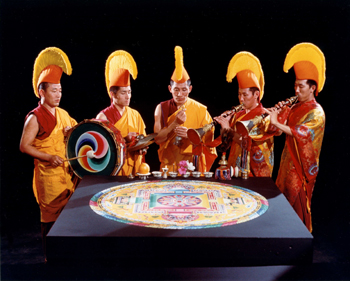![[Metroactive Music]](/gifs/music468.gif)
[ Music Index | North Bay | Metroactive Home | Archives ]
Sacred Sound
Gyuto choir caps a weeklong Tibetan art series at LBC
By Greg Cahill
A full autumn moon lit the narrow path for Huston Smith as he worked his way along a steep, narrow mountain path toward a ceremonial tent at the Gyuto monastery. The year was 1964 and Smith--then professor of philosophy and world religions at MIT--had come to this secluded refuge in India's Punjab region to study about the Tibetan Buddhist tradition.
He came away with one of the greatest musicological discoveries of the century.
The day after his arrival, the 88 Gyuto monks entered a four-day observance of a high holy day. At 3am Smith joined them. "It started with a low guttural and rhythmic chanting that had certain awesomeness to it, but it was nothing really distinctive musically," recalls Smith, now a professor emeritus at UC Berkeley and the author of a definitive book on comparative world religions. "That went on for about an hour when suddenly they splayed out into multiphonic singing."
His first thought was that the monks were singing collectively in chords, which in itself seemed strange because Smith understood harmony was a Western invention, Asia having concentrated on rhythmic and melodic lines.
"But that was nothing compared to what followed, says Smith, who soon realized that the monks were able individually to intone a three-part chord--a feat thought by Westerners to be impossible. "After about ten minutes of this chordal chanting, the choir cut out and left it to a single cantor. There he was, ten or 12 feet away from me, and the entire three-note chord was coming out of his larynx.
"I became truly astonished. It sounded like the holiest sound I had ever heard."
The North Bay is a long way from the Indian border, where the Gyuto order has worshipped and studied since its expulsion from Tibet by the Communist Chinese in 1959, a time that saw the Dalai Lama go into exile. Nevertheless, during the past 15 years, these monks have made the region a way station on their fundraising journeys. The monks have performed several times at the Marin Center and the Luther Burbank Center and in 1988 stopped over at George Lucas' Skywalker Ranch, where Grateful Dead drummer and ethnomusicologist Mickey Hart recorded the monks' second and most commercially successful album, Freedom Chants from the Roof of the World (Rykodisc).
The Gyuto monks of the Drepung Loseling Monastery perform their multiphonic singing on Thursday, Oct. 23, at the Luther Burbank Center in Santa Rosa. The concert culminates a weeklong series of events that included the creation of an intricate sacred sand painting, lectures, and a dance concert.
Of course, the important thing to remember about the monks' concert is that this is not a "performance" in the traditional sense; the monks are conducting a powerful series of ritual prayers that is incredibly stirring and remarkable to behold. "Their chanting conveys a sense of transformation and transfiguration that is an extraordinarily moving spiritual experience that translates on a level far beyond musical style," says Fred Lieberman, professor of music at the University of California at Santa Cruz and a leading authority on multiphonic singing.
In recent years, Western audiences have become familiar with an excellent example of the overtone folk style through various recordings and performances by Tuvan throat singers, featured in the Oscar-nominated film Genghis Blues. The isolated Tuvan people, living in Central Asia, use their vocal chords to shape the vocal cavity to resonate whistling melodies or produce earth-rumbling guttural chants. It's impressive and astonishing, but a far less refined method than that used by the monks.
"The monks take a single note from the upper overtones and enhance it so that it functions like a musical halo that gives a shine and a burnish to those tones, which usually are the sacred words," says Lieberman, adding that although Western ensembles like the New York Harmonic Choir have mastered the technique, the monks of the Drepung Loseling Monastery give it a spiritual quality unduplicated by others.
[ North Bay | Metroactive Central | Archives ]
Copyright © Metro Publishing Inc. Maintained by Boulevards New Media.
![]()

Artists Under Fire: The monks of the Gyuto Monastery practice their ancient Tibetan arts in exile in India.
The Mystical Arts of Tibet events continue through Sunday, Oct. 26, at the Luther Burbank Center. The chanting monks will perform Thursday, Oct. 23, at 8pm at the LBC. Tickets are $20-$48. For tickets call, 707.546.3600. For a complete schedule of events, visit www.lbc.net.
From the October 23-29, 2003 issue of the North Bay Bohemian.